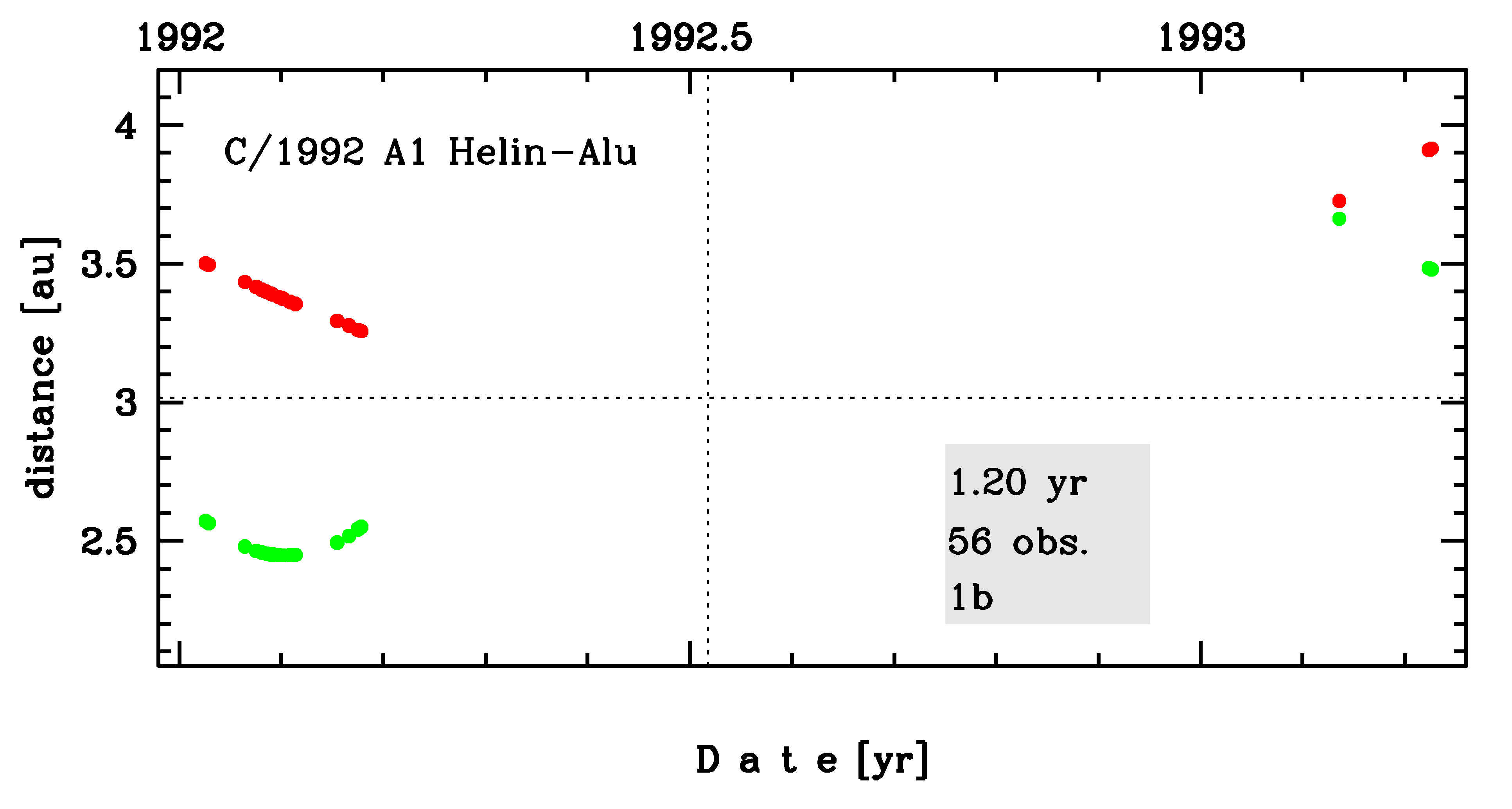C/1992 A1 Helin-Alu
more info
Comet C/1992 A1 was discovered on 9 January 1992 by Eleanor F. Helin and Jeff Alu during the course of the near-Earth asteroid survey (Mount Palomar, California, USA),that is about 6 months before its perihelion passage. This comet was last observed in the second half of March 1993.
Comet had its closest approach to the Earth on 6 February 1992 (2.448 au), about a month after its discovery.
Solution given here is based on data spanning over 1.20 yr in a range of heliocentric distances: 3.50 au – 3.02 au (perihelion) – 3.92 au.
This Oort spike comet suffers tiny planetary perturbations during its passage through the planetary system; however, these perturbations lead to escape the comet on hyperbolic orbit from the planetary zone.
See also Królikowska 2020.
Comet had its closest approach to the Earth on 6 February 1992 (2.448 au), about a month after its discovery.
Solution given here is based on data spanning over 1.20 yr in a range of heliocentric distances: 3.50 au – 3.02 au (perihelion) – 3.92 au.
This Oort spike comet suffers tiny planetary perturbations during its passage through the planetary system; however, these perturbations lead to escape the comet on hyperbolic orbit from the planetary zone.
See also Królikowska 2020.
| solution description | ||
|---|---|---|
| number of observations | 56 | |
| data interval | 1992 01 09 – 1993 03 23 | |
| data type | perihelion within the observation arc (FULL) | |
| data arc selection | entire data set (STD) | |
| range of heliocentric distances | 3.5 au – 3.02 au (perihelion) – 3.92 au | |
| detectability of NG effects in the comet's motion | NG effects not determinable | |
| type of model of motion | GR - gravitational orbit | |
| data weighting | NO | |
| number of residuals | 107 | |
| RMS [arcseconds] | 1.34 | |
| orbit quality class | 1b | |
| previous orbit statistics, both Galactic and stellar perturbations were taken into account | ||
|---|---|---|
| no. of returning VCs in the swarm | 4403 | * |
| no. of escaping VCs in the swarm | 598 | |
| no. of hyperbolas among escaping VCs in the swarm | 162 | |
| previous reciprocal semi-major axis [10-6 au-1] | 24.04 – 43.20 – 74.16 | R |
| previous perihelion distance [au] | 2.9 – 440 – 2600 | R |
| previous aphelion distance [103 au] | 27 – 46 – 81 | R |
| time interval to previous perihelion [Myr] | 1.6 – 3.1 – 8.1 | R |
| percentage of VCs with qprev < 10 | 35 | |
| percentage of VCs with qprev > 20 | 65 | |
| previous_g orbit statistics, here only the Galactic tide has been included | ||
|---|---|---|
| no. of returning VCs in the swarm | 4366 | * |
| no. of escaping VCs in the swarm | 635 | |
| no. of hyperbolas among escaping VCs in the swarm | 162 | |
| previous reciprocal semi-major axis [10-6 au-1] | 24.62 – 46.70 – 74.24 | R |
| previous perihelion distance [au] | 3.1 – 3.9 – 56 | R |
| previous aphelion distance [103 au] | 27 – 43 – 81 | R |
| time interval to previous perihelion [Myr] | 1.6 – 3.1 – 8 | R |
| percentage of VCs with qprev < 10 | 75 | |
| percentage of VCs with 10 < qprev < 20 | 7 | |
| percentage of VCs with qprev > 20 | 18 | |
